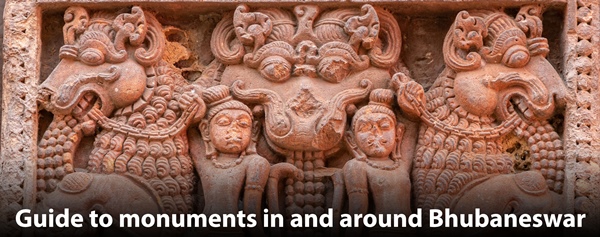Located on the east bank of Bindu Sagar tank in old Bhubaneswar, the west-facing Ananta Vasudeva Temple is the only surviving Vaishnava shrine in the city, and the second biggest monument after the famous Lingaraja Temple.
Architecturally it is similar to Lingaraja Temple but on a reduced scale, with the bhoga mandapa, nata mandapa (both later additions), jagamohana and deul, all dramatically ascending in height and aligned west-east.
The temple is profusely adorned although many of the carvings are now damaged. In general the foliate ornamentation is more elaborate than that of Lingaraja, although the mouldings are of smaller and simpler schemes.
Clearly some renovation has occurred here in recently years, most obviously with the Jagamohana which is now supported by steel girders clad around the exterior. This does obstruct some of the carvings unfortunately, but a worthy compromise if it keeps the structure safe.
Many of the sculptured figures resemble those of the contemporary Sun Temple at Konark, and we know this temple is broadly contemporary thanks to a foundation inscription that was discovered here.
The foundation inscription along with three others were originally removed from the city by Major General Charles Stuart, and now resides at the hall of the Royal Asiatic Society in London.
It tells us that Ananta Vasudeva was built in 1278 A.D. by Queen Chandrika of the Eastern Ganga dynasty, daughter of Anangabhima III, during the reign of his grandson Bhanudeva. The inscription also refers to Bindu Sagar tank, thus proving it pre-dates the current temple structure, and the original deities installed were Baladeva (Ananta), Subhadra, and Krishna (Vasudeva).
Scholars believe the temple we see today was built on an earlier structure that was dedicated to Vishnu. The Marathas extensively renovated the temple in the late 17th century when they ruled over Kalinga.
Ananta Vasudeva is very much a living temple, more than any other temple I was able to visit in Bhubaneswar. The temple houses the biggest kitchen in the city, the north and east sides of the temple compound are filled with the hustle and bustle of daily food preparation.
Food is prepared here for thousands of devotees every day in earthen pots cooked over hearths in subsidiary buildings. The food never contains tomatoes or potatoes as they are not indigenous to India. Onion and garlic are also omitted as they are considered forbidden food in spiritual practices.
Over 150 people work for the temple kitchen, the food is of course considered holy and locals purchase the prasad for functions and rituals in their own home.
All this activity from the kitchen did pose me some difficulties in documenting the temple. It was clear if I spent any time in the northern part of the compound I would be constantly getting in the way of their jobs, so I decided to be content with just observing from afar.
Please ‘Like’ or add a comment if you enjoyed this blog post. If you’d like to be notified of any new content, just sign up by clicking the ‘Follow’ button. If you have enjoyed this or any other of my posts, please consider buying me a coffee. There’s a facility to do so on the righthand side of this website for desktop users, and just above the comment section for mobile users. Thank you !
If you’re interested in using any of my photography or articles please get in touch. I’m also available for any freelance work worldwide, my duffel bag is always packed ready to go…
KevinStandage1@gmail.com
kevinstandagephotography.wordpress.com
Categories: Ananta Vasudeva Temple, Bhubaneswar, India, Odisha










































